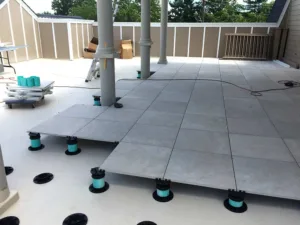Replacing teak decks with fiberglass involves several steps and considerations. Here’s a simplified guide to help you understand the process and its benefits:

replacing teak decks with fiberglass
1. Reasons for Replacing Teak with Fiberglass
- Maintenance: Teak decks require regular cleaning, oiling, and can degrade over time, especially if exposed to harsh marine environments. Fiberglass, on the other hand, is much easier to maintain.
- Durability: Fiberglass is highly durable and resistant to the elements, making it a long-lasting option compared to teak.
- Cost: Although the initial cost of fiberglass can be higher, the reduced maintenance requirements can make it more cost-effective over time.
2. Preparation for Replacement
- Deck Inspection: The existing deck and subdeck need to be thoroughly inspected for any structural damage or decay which might need to be addressed before the new decking is installed.
- Removal of Old Decking: The old teak decking needs to be completely removed. This can be labor-intensive, especially if the teak is fastened with screws or adhesives.
3. Installation of Fiberglass Decking
- Surface Preparation: Once the teak is removed, the underlying surface must be cleaned and prepared to ensure it is smooth and free from any debris or damage. Any needed repairs to the subdeck should be completed at this stage.
- Fiberglass Layup: Fiberglass decking is typically installed using layers of fiberglass mat or cloth and resin. The resin is applied over the mat, and then additional layers are added as required. Each layer must cure before the next is applied.
- Finishing: Once the fiberglass has cured, it will likely need to be sanded to create a smooth finish. It can then be painted or gel-coated to provide color and additional protection.
4. Considerations
- Weight: Fiberglass might add more weight to the deck compared to teak, which could affect the vessel’s performance and handling.
- Skill Required: The process of laying fiberglass is specialized and can be quite tricky. It often requires professional expertise to ensure that the deck is watertight and properly adhered.
- Appearance: While fiberglass can be finished in a variety of colors and textures, it won’t have the same natural look as teak.
5. Costs
- Material Costs: Fiberglass materials (mat, resin, gelcoat) generally are less expensive than new teak wood, but the cost can vary based on the quality and the specifics of the project.
- Labor Costs: Professional installation can be costly given the expertise and labor involved, especially in a large project like replacing a boat deck.
6. Maintenance
- Cleaning: Fiberglass decks are relatively easy to maintain, usually needing only routine washing with soap and water.
- Repairs: If damaged, fiberglass can be repaired with new layers of fiberglass and resin, though color matching might be necessary to maintain aesthetics.
7. Longevity and Value
- Longevity: A well-installed fiberglass deck can last many years without the need for significant maintenance.
- Resale Value: Upgrading to fiberglass might affect the boat’s resale value, either positively due to reduced maintenance needs, or negatively if buyers prefer the traditional look and feel of teak.
Switching from teak to fiberglass decking is a significant decision that involves weighing factors like cost, maintenance, and aesthetics. If you decide to proceed, hiring a professional with experience in fiberglass deck installations is highly recommended to ensure a successful and durable finish.




























